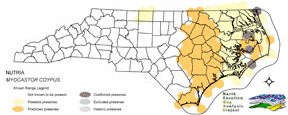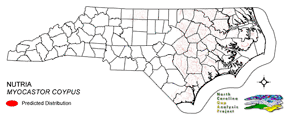
| Taxa: |
| Order: |
| Family: |
| Mammalia |
| Rodentia |
| Myocastoridae |
| NatureServe Global Rank: |
| NatureServe State (NC) Rank: |
| G5 |
| SE |
| Federal Status: |
| NC State Status: |
| --- |
| --- |


| Land Unit |
| US Fish & Wildlife Service |
| US Forest Service |
| US National Park Service |
| US Department of Defense |
| NC State Parks |
| NC University System |
| NC Wildlife Res. Com. |
| NC Forest Service |
| NC Div. of Coastal Mgmt. |
| Local Governments |
| Non-Governmental Org. |
| Other Public Lands |
| Private Lands |
| GAP Status 1-2 |
| All Protected Lands |
| Statewide |
| Hectares |
| 7,880.94 |
| 1,024.74 |
| 4,157.73 |
| 1,847.43 |
| 1,703.16 |
| 385.38 |
| 2,089.71 |
| 7.38 |
| 586.08 |
| 20.61 |
| 1,619.19 |
| 43.74 |
| 185,848.47 |
| 14,332.23 |
| 21,290.13 |
| 207,214.56 |
| Acres |
| 19,474.22 |
| 2,532.19 |
| 10,273.97 |
| 4,565.10 |
| 4,208.60 |
| 952.29 |
| 5,163.78 |
| 18.24 |
| 1,448.23 |
| 50.93 |
| 4,001.10 |
| 108.08 |
| 459,241.48 |
| 35,415.70 |
| 52,609.05 |
| 512,038.23 |
| % of Dist. on |
| Prot. Lands |
| 37.0 % |
| 4.8 % |
| 19.3 % |
| 8.7 % |
| 8.0 % |
| 1.8 % |
| 9.6 % |
| < 0.1 % |
| 2.8 % |
| 7.6 % |
| 7.6 % |
| 0.2 % |
| 0.1 % |
| 67.3 % |
| ----- |
| ----- |
| % of Dist. on |
| All Lands |
| 3.8 % |
| 0.5 % |
| 2.0 % |
| 0.9 % |
| 0.8 % |
| 0.2 % |
| 1.0 % |
| < 0.1 % |
| 0.3 % |
| < 0.1 % |
| 0.8 % |
| < 0.1 % |
| 89.7 % |
| 6.9 % |
| ----- |
| ----- |
|
Presently, populations of nutria (introduced to the mid-Atlantic states from South America) are largely confined to tidewater habitats in central and northern sections of the Outer Banks and coastal plain (Lee et al. 1982, Webster et al. 1985). However, their range may be expanding inland and southward. Nutria have much the same habitat requirements as muskrats, potentially putting the two in competition for resources (Whitaker and Hamilton 1998). These large rodents (just a bit smaller than beavers) will also dwell in other low-country watery habitats; including, ponds, canals and lakes (Brown 1997). NATURE SERVE GLOBAL HABITAT COMMENTS: Prefers freshwater marshes; also in brackish marshes. Nests in burrows, abandoned muskrat houses, or in dense vegetation. |
| Code | Name | Description | NC Natural Heritage Program Equivalent |
| 3 | Tidal Marsh | Fresh and brackish tidal marshes, including cord grass, wild rice, sawgrass and needlerush alliances. | Brackish Marsh, Interdune pond, Maritime wet grassland |
| 124 | Maritime Scrubs and Tidal Shrublands | Coastal shrubs including wax-myrtle, swamp rose, alder, yaupon, and greenbriar. | Maritime Shrubs, Salt Shrub |
| 75 | Tidal Swamp Forest | Swamp tupelo dominated forest with or without black tupelo and/or cypress trees. Restricted to the tidal zones in the coastal plain. May have inclusions of coastal red cedar woodlands. | Tidal cypress - gum swamp |
| 380 | Coastal Plain Fresh Water Emergent | Emergent vegetation in fresh water seepage bogs, ponds and riverbeds of the coastal plain. Includes alliances dominated by sedges, eelgrass, as well as cane found in unforested cane-brakes. | Small Depression Pond, Sandhill Seep, Floodplain Pool, Unforested Floodplain Canebrake, Riverscour Prairies, Vernal Pools |
| 173 | Coastal Plain Riverbank Shrubs | Shrub dominated riverbanks, commonly dominated by willows and/or alders. | Sand and Mud Bar |
| 50 | Coastal Plain Mixed Bottomland Forests | Includes forests dominated by a variety of hardwood species, including sweetgum, cottonwood, red maple. | Coastal Plain Bottomland Hardwood (in part), Coastal Plain Levee Forest |
| 49 | Coastal Plain Oak Bottomland Forest | Bottomland forests dominated by deciduous oak alliances. Oaks represented can include swamp chestnut, cherrybark, willow, and/or overcup oak. Inclusions of loblolly pine temporarily flooded forests occur in patches. Hydrology is temporarily to seasonally flooded. | Coastal Plain Bottomland Hardwoods (in part) blackwater subtype, brownwater subtype |
| 41 | Peatland Atlantic White-Cedar Forest | Dense stands of Atlantic white cedar with saturated hydrology. Can include swamp tupelo, red maple, and pond pines with a moderate shrub and herb layer. | Peatland Atlantic White-Cedar Forest |
| 15 | Seepage and Streamhead Swamps | Includes extensive peat flats in the coastal plain, dominated by swamp tupelo, maples, and Atlantic white cedar alliances. In the sandhills includes streamhead pond pine and bay forests alliances. Saturated hydrology. | Bay Forest, Small Depression Pocosin, Streamhead Atlantic White Cedar Forest, Streamhead Pocosins |
| 30 | Cypress-Gum Floodplain Forests | Swamps dominated by black or swamp tupelo with or without Taxodium. Seasonally to semi-permanently flooded hydrology. | Cypress-Gum Swamps |
| 78 | Pond-Cypress - Gum Swamps, Savannas and Lakeshores | Cypress dominated swamps and lakeshores. Can include bays dominated by pond cypress or shorelines of coastal plain lakes with a narrow band of cypress. | Non-riverine Swamp Forest, Natural Lakeshores (in part) |
| 385 | Oak Bottomland Forest and Swamp Forest | The swamp chestnut oak, cherrybark oak, shumard oak and sweetgum alliance is one representative. Other alliances are dominated by water, willow, and overcup oaks. Swamp forests can be dominated by sweetgum, red maple, and black gum being dominant. Loblolly can occur in combination with sweetgum and red maple, or with tulip poplar. Includes saturated and semi- to permanently flooded forests in the mountains. | Piedmont/Mountain Bottomland Forest, Piedmont/Mountain Swamp Forest |
| 238 | Piedmont/Mountain Submerged Aquatic Vegetation | Seasonally to permanently flooded areas with aquatic vegetation. Waterlily, pondweed, hydrilla smartweed are a few of the species that can occur. | Piedmont/Mountain Semipermanent Impoundment (in part) |
| 239 | Piedmont/Mountain Emergent Vegetation | Emergent vegetation of all wetland hydrologies. Sites would commonly support species such as tussock sedge, rushs, and cattail alliances. | Rocky Bar and Shore (in part) |
| 267 | Riverbank Shrublands | Riverside shrubs with temporarily flooded hydrologies. Found in the both the Mountains and Piedmont. Containing dominants such as smooth alder and a Carolina or black willows. | Sand and Mud Bar |
| 269 | Floodplain Wet Shrublands | Saturated shrublands of the Piedmont, includes buttonbush, swamp-loosestrife, decodon and alders. | Piedmont/mountain Semipermanent Impoundment |
| 384 | Piedmont/Mountain Mixed Bottomland Hardwood Forests | Includes temporarily to seasonally forests dominated by hardwood species. Hardwoods include sweetgum, red maple, sycamore which co-occur in a mosaic of bottomland and levee positions. Includes alluvial hardwood forests in the mountains. Hemlock and white pine may occur as inclusions, but are generally mapped separately. | Piedmont/Mountain Alluvial Forest, Piedmont/Mountain Levee Forest |
| 8 | Open water | Open water without aquatic vegetation. | No equivalent |
|
Jones, J. K., Jr., et al. 1992. Revised checklist of North American mammals north of Mexico, 1991. Occas. Pap. Mus., Texas Tech Univ. (146):1-23.
Wilson, D. E., and D. M. Reeder (editors). 1993. Mammal Species of the World:a Taxonomic and Geographic Reference. Second Edition. Smithsonian Institution Press, Washington, DC. xviii + 1206 pp. Brown, L. N. 1997. A guide to the mammals of the southeastern United States. University of Tennessee Press, Knoxville. xiv + 236 pp. Whitaker, J.O. Jr. and W.J. Hamilton, Jr. 1998. Mammals of the eastern United States. Cornell Univ. Press, Ithaca, New York. 583 pp. Lowery, G. H., Jr. 1974. The mammals of Louisiana and its adjacent waters. Louisiana State University Press, Baton Rouge. 565 pp. Lee, D. S., L. B. Funderburg Jr., and M. K. Clark. 1982. A distributional survey of North Carolina mammals. Occasional Papers of the North Carolina Biological Survey, No. 1982-10. North Carolina State. Mus. Nat. Hist., Raleigh, North Carolina. 72 pp. Jackson, D. D. 1990. Orangetooth is here to stay. Audubon, July 1990, pp. 89-94. Evans, J. 1970. About nutria and their control. U.S. Fish& Wildl. Serv. Res. Publ. 86:1-65. Davis, W. B. 1978. The mammals of Texas. Texas Parks and Wildlife Dept., Bull. No. 41. 294 pp. Hamilton, William J., Jr., and John O. Whitaker, Jr. 1979. Mammals of the eastern United States. Cornell Univ. Press, Ithaca, New York. 346 pp. Willner, G. R., J. A. Chapman, and D. Pursley. 1979. Reproduction, physiological responses, food habits, and abundance of nutria on Maryland marshes. Wildl. Monogr. No. 65:1-43. Hall, E. R. 1981. The Mammals of North America. Second edition. 2 Volumes. John Wiley and Sons, New York, New York. Webster, W. D., J. F. Parnell and W. C. Biggs Jr. 1985. Mammals of the Carolinas, Virginia, and Maryland. The University of North Carolina Press, Chapel Hill, NC. |
For more information please contact them at:
NC-GAP Analysis Project
Dept. of Zoology, NCSU
Campus Box 7617
Raleigh, NC 27695-7617
(919) 513-2853
www.basic.ncsu.edu/ncgap